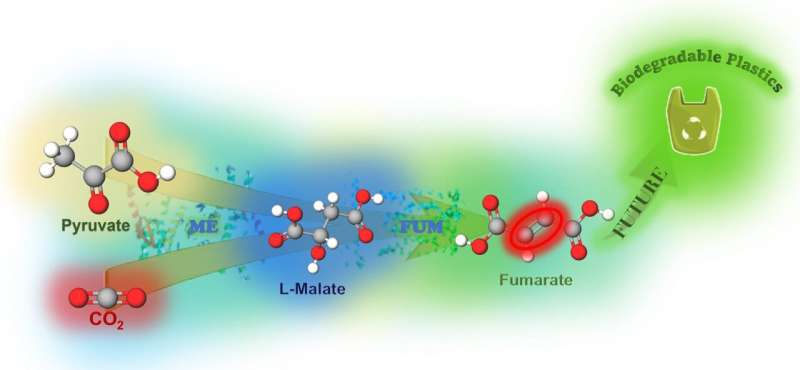Lessons from natural photosynthesis for conversion of CO2 to raw materials for plastic

In plants, natural photosynthesis binds carbon dioxide (CO2) to organic compounds, which can then be converted into glucose or starch. These useful molecules can be sequestered, storing the carbon in a solid form. Artificial photosynthesis mimics this process by reducing the greenhouse gas CO2—the main cause of climate change—which is converted into other useful substances.
Researchers from Osaka Metropolitan University have managed to create fumarate using artificial photosynthesis on pyruvate and CO2. This fumarate can be used to make biodegradable plastic like polybutylene succinate, storing the carbon in a compact, durable, solid form. Currently, most fumarate used to make this plastic is produced from petroleum, so creating fumarate from CO2 and biomass-derived pyruvate is highly desirable.
Professor Yutaka Amao from the Research Center for Artificial Photosynthesis and Mika Takeuchi, a graduate student at the Osaka Metropolitan University Graduate School of Science, used the biocatalyst malate dehydrogenase (oxaloacetate-decarboxylating) to combine CO2 with pyruvate, derived from biomass, to produce L-malic acid. Subsequently, the biocatalyst fumarase was used to dehydrate the L-malic acid to synthesize fumarate.
"The biocatalysts were used to convert CO2 into a raw material for plastic. Based on our results, we will continue to construct better CO2 conversion systems with an even lower environmental impact; we are aiming for more efficient conversion of CO2 into useful substances, using light energy," said Prof. Amao.
With this success, the team has already begun researching new methods of artificial photosynthesis with the goal of producing fumarate using light as energy. If this technology can be realized, it will create a new artificial photosynthetic system to synthesize useful macromolecules from CO2.
The current study is published in Reaction Chemistry & Engineering.
More information: Mika Takeuchi et al, Biocatalytic fumarate synthesis from pyruvate and CO2 as a feedstock, Reaction Chemistry & Engineering (2022).
Provided by Osaka Metropolitan University



















